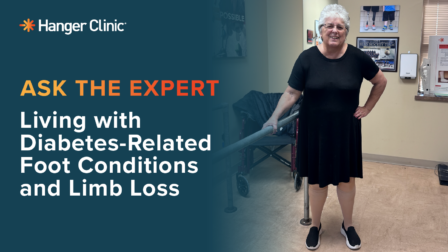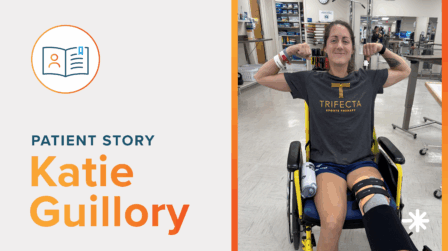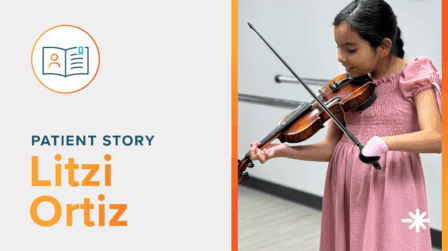The Hanger Institute for Clinical Research & Education Releases 2024/2025 Annual Report Highlighting Efforts to Improve Clinical Outcomes and Patient Care
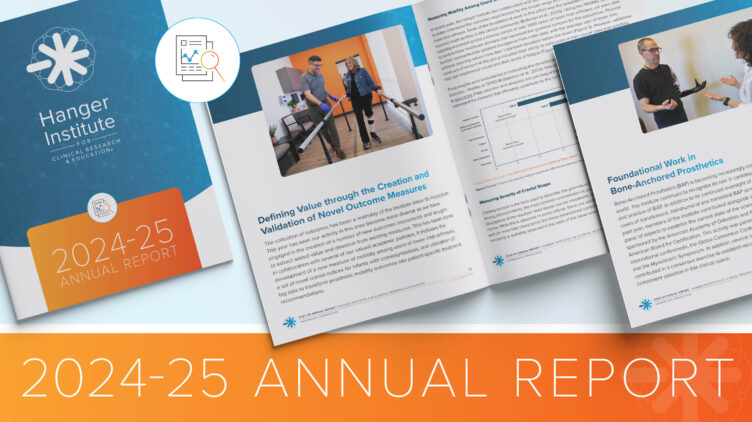
The Hanger Institute for Clinical Research and Education released its 2024/2025 Annual Report focused on the Institute’s mission of advancing clinical practice through leading-edge research and quality education in the field of orthotics and prosthetics (O&P). Made possible by strategic collaboration and partnerships with a wide range of academic and clinical institutions, this report reflects the efforts made to improve clinical outcomes and provide evidence-based care through research, innovation, and clinical integration.
Hanger Institute Annual Report
Review the progress the Hanger Institute for Clinical Research & Education has made to help improve clinical outcomes and provide evidence-based care.
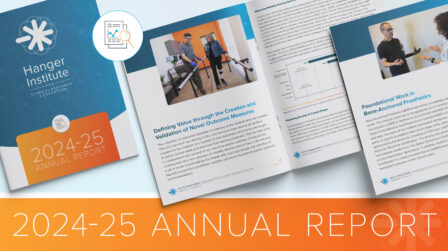
The Hanger Institute and its partners have continued to advance novel outcome measures that better capture the real-world impact of care and explored the integration of artificial intelligence to support clinical decision making. They have also generated critical evidence in support of microprocessor technologies and contributed foundational work in bone-anchored prosthetics. Most importantly, the Institute continued to elevate the voice of the patient—incorporating patient preferences more directly into care pathways and outcomes research.
The Institute has remained steadfast in its commitment to knowledge translation and education through peer-reviewed publications, clinical residencies, and strategic collaborations that connect evidence-based research to real-world practice. Our mission is to explore, expand, and facilitate opportunities that advance science and improve patient care across the O&P field, and ultimately to empower every patient to pursue and achieve their goals.
Shane Wurdeman, PhDChief Clinical Officer
Highlights from the 2024/2025 Annual Report
Enabling Improved Outcomes with Microprocessor Technology
The impact of microprocessor control on improving the safety and mobility of individuals with transfemoral prostheses who are active walkers in their communities has long been realized. More recently, microprocessors have been successfully integrated into lower limb orthoses and prosthetic knee joints designed for more limited walkers. The Institute has been very active in measuring the impact of these new technologies in the lives of these new patient populations, informing clinicians and policymakers on the realized value of these interventions.
- A multi-site clinical trial led by the Hanger Institute and Ottobock found that microprocessor-controlled KAFOs (MPKAFOs) significantly improved balance, mobility, and reduced fall risk in users compared to traditional KAFOs, with an 80% decrease in reported falls (Ruetz et al., 2024).
- In response, Hanger Clinic launched a structured national MPKAFO program to expand access and train clinicians, ensuring broader adoption and consistent patient care.
- A preliminary analysis of follow-up data is promising, with 82% of patients demonstrating improvement on the Berg Balance Scale (BBS), 95% of patients showing increased mobility as measured by the OPRO-M, and 52% reporting a reduction in the extent to which pain interfered with their daily tasks at home, at work, and in the community.
- The ASCENT K2 clinical trial found that individuals over 65 with above-knee amputations and limited mobility (K2 level) experienced significantly fewer falls and near-falls when using microprocessor knees (MPKs) compared to non-MPKs—reporting about one-third as many fall-related events (Kannenberg & Wurdeman, 2024).
- Participants using MPKs showed reduced fear of falling, fewer avoidance behaviors, and faster mobility performance, supporting expanded MPK access through recent CMS policy changes for older, mobility-limited individuals who were traditionally excluded from advanced prosthetic options.
Defining Value through the Creation and Validation of Novel Outcome Measures
The collection of outcomes has been a mainstay of the Institute since its inception. This year has seen our activity in this area become more diverse as we have engaged in the creation of a number of new outcomes instruments and sought to extract added value and direction from existing measures. This has been done in collaboration with several of our valued academic partners.
- Development of a new measure of mobility among users of lower limb orthoses.
- Development of a set of novel cranial indices for infants with craniosynostosis.
- Utilization of big data to transform prosthetic mobility outcomes into patient-specific treatment recommendations.
Foundational Work in Bone-Anchored Prosthetics
Bone-Anchored Prosthetics (BAP) is becoming increasingly common around the world. The Institute continues to recognize its role in contributing to the science and practice of BAP. In addition to its continued oversight of dozens of individual cases of transfemoral, transhumeral and transtibial BAP across the nation, this past year, members of the Institute contributed alongside a multi-disciplinary panel of experts to establish the current state of the science of BAP in meetings sponsored by the American Academy of Orthotists and Prosthetists and the American Board for Certification.
Continued Efforts to Advance Clinical Outcomes for Individuals with Upper Limb Amputation
Having established the predictive value of bimanual function, activity and participation levels and pain interference on the well-being of individuals with upper limb amputation, the Institute began to look at the longitudinal impacts of prosthesis receipt on these variables. We continue to share these findings in appropriate academic settings including international conferences and editorial articles in one of the field’s peer-reviewed journals.
- The Hanger Institute’s previous research on upper limb prostheses revealed that receiving a prosthesis significantly improves patients’ ability to engage in daily life activities and reduces the extent to which pain interferes with those activities, as shown by a rise in APSRA scores and a drop in avoidance linked to pain (Steven et al., 2023).
- The PROMIS-9 Upper Extremity instrument proved responsive and clinically valuable, effectively capturing gains in bimanual function and offering a solid tool to support personalized rehabilitation strategies (Castleberry et al., 2024).
- These findings underscore the importance of patient-centered care and support the early integration of bimanual training in prosthetic rehabilitation (Stevens et al., 2024).
- The evidence strengthens the case for thoughtful prosthetic design and targeted therapy to enhance the well-being of individuals with upper limb loss.
Integrating Patient Preferences into Clinical Decision Making
The Hanger Institute has been working diligently to help improve patient outcomes. This includes our recent efforts to enable shared decision making to help patients feel more involved and a part of their clinical care team.
Enhancing Clinical Care through Artificial Intelligence
Artificial Intelligence is changing the landscape of healthcare and practice management. Within Hanger, we are turning to AI to provide solutions as clinicians seek to balance increased documentation requirements without sacrificing the ability to build and retain important relationships with patients. This is being done through ambient listening technologies, a referral note summary tool and the generation of synthesized clinical narratives. The dramatic increase in utilization of these tools across our national network of clinics is a testament to their utility and enhanced efficiencies.
About the Hanger Institute for Clinical Research and Education
The Hanger Institute for Clinical Research and Education is an assembly of experts and resources dedicated to advancing clinical practice and improving patient outcomes through leading-edge research, evidence-based care, and quality education.
More Published Research
Review additional studies conducted by the Hanger Institute for Clinical Research and Education, in collaboration with leading researchers, clinical, and academic institutions.
References
• Ruetz, A., DiBello, T., Toelle, C., Hemmen, B., Wening, J., Weber, E., Braatz, F., Winkler, T., Steinfeldt, F., Umari, M., Rupp, R., Kluge, S., Krebs, A., & Wurdeman, S. (2024). A microprocessor stance and swing control orthosis improves balance, risk of falling, mobility, function, and quality of life of individuals dependent on a knee-ankle-foot orthosis for ambulation. Disability and Rehabilitation, 46(17), 4019–4032. • Kannenberg, A., & Wurdeman, S. (2024, September 12–15). Assessing outcomes with microprocessor knee utilization in a K2 population (ASCENT K2): Findings from a clinical trial of 107 individuals with above-knee amputation [Conference presentation]. AOPA National Assembly, Charlotte, NC. • Stevens, P., England, D., Todd, A., Mandacina, S., & Wurdeman, S. (2023). Activity and participation, bimanual function, and prosthesis satisfaction are strong predictors of general well-being among upper limb prosthesis users. Archives of Rehabilitation Research and Clinical Translation, 5(2), 100264. • Castleberry, T. (2024, September 12–15). Responsiveness of PROMIS-9 UE physical function to prosthesis rehabilitation [Conference presentation]. AOPA National Assembly, Charlotte, NC. • Stevens, P., Todd, A., & Dunbar, K. (2024). Editor’s comments: Informing upper-limb prosthetics training practice and priorities with recent evidence. Journal of Prosthetics and Orthotics, 36(4), 215–216.
Latest Updates
Subscribe to stay up-to-date on our latest posts.
